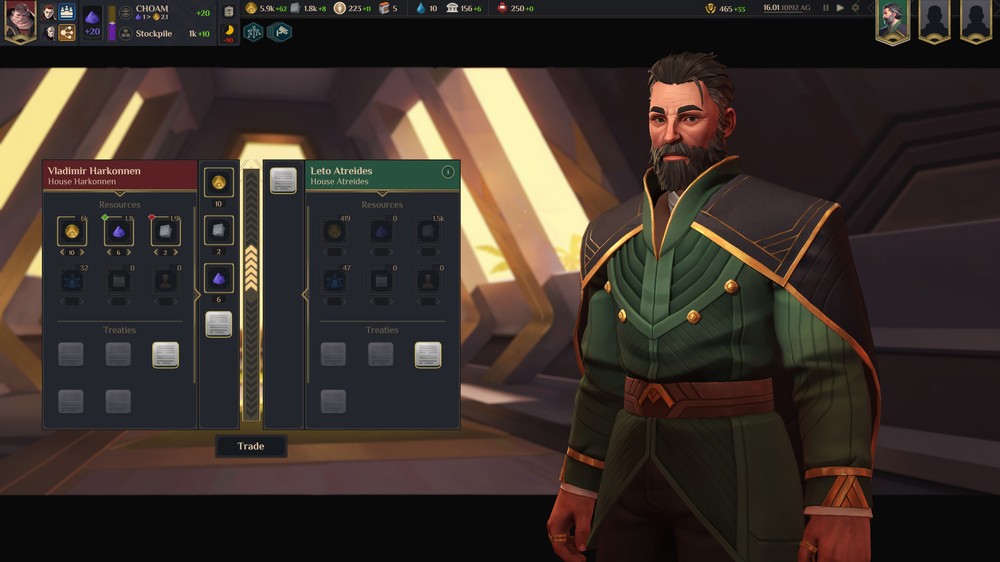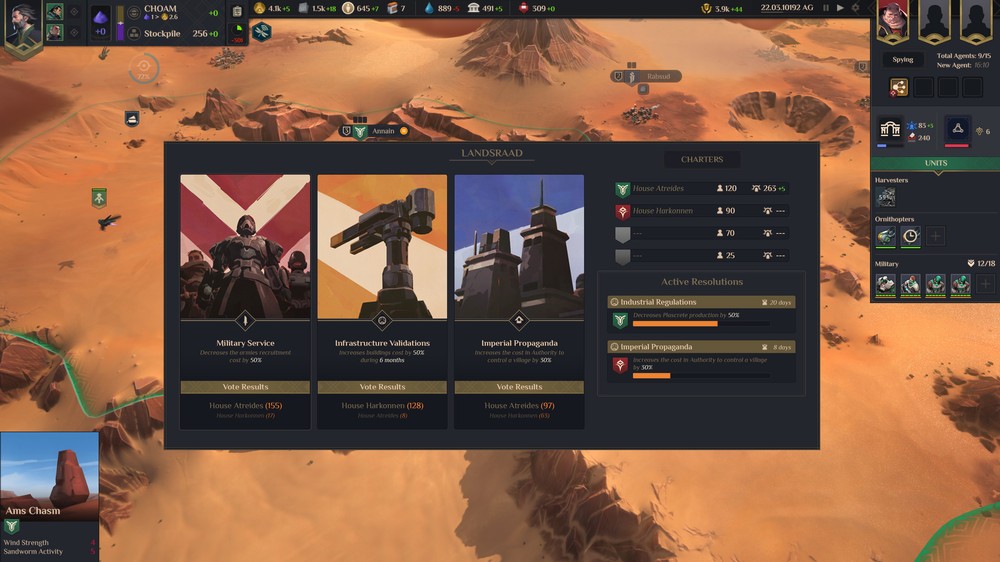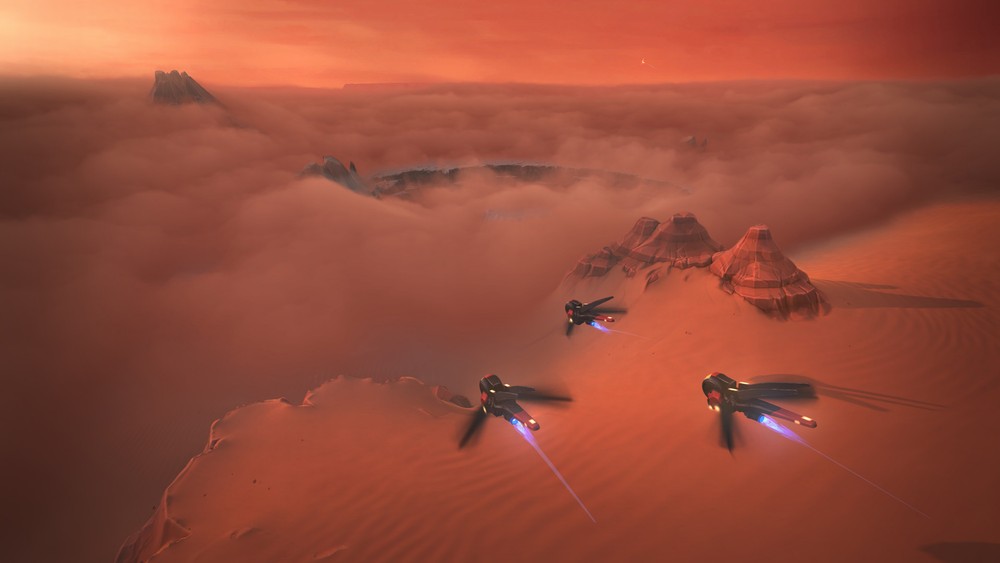Early Access Review – May 4, 2022
Dune: Spice Wars, is the latest title from Shiro Games, the team behind RTS sweetheart, Northgard. A mix of RTS and 4X elements bring Dune into the 2020s. Players coming in may see the words “early access” and assume they’re in for an unbalanced, unfinished mess, a valid concern in any situation. While some aspects still need work, Shiro comes out of the gate with a strong showing and a promising glimpse of the things to come.
 At first glance, Dune: Spice Wars, looks like Northgard with a desert reskin and the addition of sandworms. The player’s territory is hex-based and can be scouted with Ornithopters that can’t be targeted and can be set to auto-scout. This expedites scouting, alleviating players from having to babysit their scouting units, a normal annoyance in RTS. Players will expand across Arrakis either by combat or annex. Unlike Northgard, combat doesn’t feel good at the moment. Winning a settlement in a combat scenario feels more like a numbers game in most situations and less about the units you are pitting against the enemy. Units across the factions all have a distinct look but all feel the same when it comes to combat. Players can build cannons and use abilities, called Operations, to buff their units and nerf enemy units. These can help shift battles, but again it just feels like a numbers game and less like winning a battle due to skill.
At first glance, Dune: Spice Wars, looks like Northgard with a desert reskin and the addition of sandworms. The player’s territory is hex-based and can be scouted with Ornithopters that can’t be targeted and can be set to auto-scout. This expedites scouting, alleviating players from having to babysit their scouting units, a normal annoyance in RTS. Players will expand across Arrakis either by combat or annex. Unlike Northgard, combat doesn’t feel good at the moment. Winning a settlement in a combat scenario feels more like a numbers game in most situations and less about the units you are pitting against the enemy. Units across the factions all have a distinct look but all feel the same when it comes to combat. Players can build cannons and use abilities, called Operations, to buff their units and nerf enemy units. These can help shift battles, but again it just feels like a numbers game and less like winning a battle due to skill.
 The four playable factions all come with unique abilities. The standout for me being the Fremen’s ability to ride the sandworms. This is honestly just to make up for the fact that they don’t have access to the airfields, which serve as the fast travel for the other three factions, but it’s fun to see the creative way the developer worked around the differences. Other differences include different levels of access to the council and information across the game. For example, the Harkonnen always know the influence flows of all factions, whereas the other factions would need to use agents to gather that information).
The four playable factions all come with unique abilities. The standout for me being the Fremen’s ability to ride the sandworms. This is honestly just to make up for the fact that they don’t have access to the airfields, which serve as the fast travel for the other three factions, but it’s fun to see the creative way the developer worked around the differences. Other differences include different levels of access to the council and information across the game. For example, the Harkonnen always know the influence flows of all factions, whereas the other factions would need to use agents to gather that information).
On Arrakis, resource management is key. One wrong choice and a deficit can leave you trying to play catch up the rest of the game. Resources are mainly gained by building structures in settlements. The most important resource of all, Spice, will drive your expansion as you work to pay your rising Imperial Spice Tax. Adding additional control, players can decide how much Spice they’ll stockpile for taxes and how much they’ll sell in the markets to build up some cash (Solari). This is a great addition that I wish was available for other resources, but at least players can trade resources with other teams, who all put different values on each resource.
 There are enough diplomatic systems in Spice Wars to shake a stick at. When selecting one of the four factions, players will also choose two councilors that give additional buffs for their build. It’s fun to mix-and-match these and try to find the perfect blend. A personal favorite of mine was the ability to impose any treaty on any faction for just fifty influence; a great ability if things are getting a little hot and you need a short-term ally.
There are enough diplomatic systems in Spice Wars to shake a stick at. When selecting one of the four factions, players will also choose two councilors that give additional buffs for their build. It’s fun to mix-and-match these and try to find the perfect blend. A personal favorite of mine was the ability to impose any treaty on any faction for just fifty influence; a great ability if things are getting a little hot and you need a short-term ally.
Influence also works its way into council votes, with recurring resolutions that all teams vote on. The more influence you hold, the more votes you get, the easier it is for you to sway the vote on certain resolutions. These give players opportunities to nerf enemies for a short amount of time or gain an advantage in resources or combat.
 For more long-term upgrades, there are four skill trees, known as developments. Each tree is catered to a specific faction, but players can mix and match the upgrades they want, which can also be sped up by collecting knowledge. This adds to the variety already presented by your choice of councilors. You can focus on powering up your already buffed stats and just be a powerhouse. You can also go the other way and try to even out your weaknesses. There will be optimized builds (they’re already on the internet, I’m sure) , but I never felt like diving down one skill tree left me at a disadvantage.
For more long-term upgrades, there are four skill trees, known as developments. Each tree is catered to a specific faction, but players can mix and match the upgrades they want, which can also be sped up by collecting knowledge. This adds to the variety already presented by your choice of councilors. You can focus on powering up your already buffed stats and just be a powerhouse. You can also go the other way and try to even out your weaknesses. There will be optimized builds (they’re already on the internet, I’m sure) , but I never felt like diving down one skill tree left me at a disadvantage.
Adding more layers is the espionage system and the ability to hire agents (read spies) to infiltrate the different factions and organizations. Each agent comes with their own special ability, which can help determine the best place for them. With infiltration, players gain intel which can be used to complete operations and gain other resources. Infiltrating an enemy faction will give you all the information you need to know about an opposing team. What are their combat capabilities? Are they around another faction? Are they running a surplus or deficit? The answers to these will help you decide the best course of action when it comes to planning out your best route to victory. Just like Northgard, there are multiple paths to victory. These add to the already established variety.
 In this early build of the game, only single player campaigns are available, with plans to add a story campaign, multiplayer, and rebalance factions sometime in the future. Love or hate roadmaps, Shiro has proved their games have legs down the road, Northgard just received its latest update back in October, over five years after release.
In this early build of the game, only single player campaigns are available, with plans to add a story campaign, multiplayer, and rebalance factions sometime in the future. Love or hate roadmaps, Shiro has proved their games have legs down the road, Northgard just received its latest update back in October, over five years after release.
Early access leaves a bad taste in some players’ mouths. There are plenty of horror stories to be had. In its current state, Dune: Spice Wars is not one of those stories. Players coming in looking for a combat heavy experience or wanting to play with friends may be disappointed. Those looking for something a little closer to a 4X experience will find much more to like here. It might be a while until Shiro reaches 1.0, but this early access feels just like the tip of the iceberg for what Spice Wars could offer.
Final Review – October 24, 2023
Add a cup of Frank Herbert’s Dune universe, a tablespoon of 4x gameplay, and a pinch of real time strategy combat; let that concoction set for 18 months in early access, and you’ll eventually have the 1.0 release of Dune: Spice Wars. In my early access coverage, I was impressed with the game’s presentation and all the 4x aspects of the gameplay. I was less impressed with its lack of game modes and combat. Shiro Games, the crew behind Northgard, have done a meticulous job of capturing the look and feel of Arrakis. From the constant threat of sandworms to the heated political theatrics between the houses of the desert planet. This is a solid adaptation of the source material. Yet, the combat, game mode variety, and lack of noticeable difference between factions leaves something to be desired. Dune: Spice Wars isn’t a poorly cooked meal; it just lacks the proper seasoning that keeps me coming back for another plate.
 Shiro Games made a name for themselves with Northgard. Aside from having long legs (they just released their tenth DLC faction five years after the game’s release) it also offers players the ability to win matches in ways outside of combat. In a genre that is generally full of sweats, winning through peaceful means such as knowledge gain or commercial influence opened the door for new players to find their footing. The same can be said for Dune: Spice Wars.
Shiro Games made a name for themselves with Northgard. Aside from having long legs (they just released their tenth DLC faction five years after the game’s release) it also offers players the ability to win matches in ways outside of combat. In a genre that is generally full of sweats, winning through peaceful means such as knowledge gain or commercial influence opened the door for new players to find their footing. The same can be said for Dune: Spice Wars.
Players start each match with a single territory and scout out in search of spice and other resources. Ornithopters are still prominent in scouting but can now also be assigned to spice harvesters as a lookout for sandworms. I like this new addition but do question its usefulness with players already having the option to automatically withdraw harvesters when a sandworm is detected. Also new since my last time with the game, water is now tied to unit provisions and their ability to replenish supplies faster, after coming back from unowned territory. Needed to fuel most buildings, water was already indispensable, but its new tie to unit provisions makes it that much more important, especially when considering your best path to victory.
 The game offers multiple paths to victory that all fit perfectly into the setting of Arrakis. Winning through governance requires players to be elected through the Landsraad. An economic win occurs when a player holds fifty-percent of the CHOAM market, which can be achieved by purchasing shares of CHOAM as they go up for sale. This was my favorite aspect of the game to interact with the more I played. The price of CHOAM is constantly changing, and is tracked through a line chart. You can also track how much CHOAM is out in the market and who owns what percentage of the market on a pie chart. If you like charts (like I do), you’ll feel right at home with the CHOAM. Hegemony victories are for players that want a little more balance in their playstyle. Hegemony plays out like Fame victories from Northgard. You earn different amounts of Hegemony for different actions such as village takeovers, getting a charter to pass in your favor, or winning a combat encounter. The 4X aspects of the game still work great. Things are clearly communicated, and the management of menus never becomes overwhelming.
The game offers multiple paths to victory that all fit perfectly into the setting of Arrakis. Winning through governance requires players to be elected through the Landsraad. An economic win occurs when a player holds fifty-percent of the CHOAM market, which can be achieved by purchasing shares of CHOAM as they go up for sale. This was my favorite aspect of the game to interact with the more I played. The price of CHOAM is constantly changing, and is tracked through a line chart. You can also track how much CHOAM is out in the market and who owns what percentage of the market on a pie chart. If you like charts (like I do), you’ll feel right at home with the CHOAM. Hegemony victories are for players that want a little more balance in their playstyle. Hegemony plays out like Fame victories from Northgard. You earn different amounts of Hegemony for different actions such as village takeovers, getting a charter to pass in your favor, or winning a combat encounter. The 4X aspects of the game still work great. Things are clearly communicated, and the management of menus never becomes overwhelming.
Combat is still an option in Dune: Spice Wars. On top of slinging units at the enemy, players can also choose to partake in assassination attempts against enemy leaders. These play out through assigning agents to spy on opposing teams. After assigning enough agents to a faction, players can initiate the assassination attempt through one of the numerous orders available in the menu. This can keep the opposition on its toes but can also backfire if the enemy is investing agents in counterintelligence, costing you both your agents and the assassination attempt.
 Assassinations add some variation to combat, but don’t save it from my biggest problem with the game. Combat is not fun and the six factions do not feel very different to play. Yes, House Harkonnen has advantages concerning operations and agents, House Atreides has a better hand in playing politics in the Landsraad, and the Fremen can ride the sandworms, but outside of stat advantages/disadvantages, and some cosmetic differences, each faction feels one-to-one in most aspects. Units in each faction have some unique appearances, but all fall under a specific archetype that act in similar way as their counterparts. A few units do stand out, like House Harkonnen’s Cerberus unit, which splits into Unchained Cerberus units upon death. Airships are also new to the game, but come in much later, once a necessary structure has been built.
Assassinations add some variation to combat, but don’t save it from my biggest problem with the game. Combat is not fun and the six factions do not feel very different to play. Yes, House Harkonnen has advantages concerning operations and agents, House Atreides has a better hand in playing politics in the Landsraad, and the Fremen can ride the sandworms, but outside of stat advantages/disadvantages, and some cosmetic differences, each faction feels one-to-one in most aspects. Units in each faction have some unique appearances, but all fall under a specific archetype that act in similar way as their counterparts. A few units do stand out, like House Harkonnen’s Cerberus unit, which splits into Unchained Cerberus units upon death. Airships are also new to the game, but come in much later, once a necessary structure has been built.
Some additional game modes have been added on top of the four-player skirmish. Players looking for a shorter experience can hop into Kanly Dunely, a two-player 1-v-1 match on a smaller map. Those with more time to burn, look no further than Conquest mode. With an overworld map, players embark on a multi-scenario adventure that pits them against multiple houses of Arrakis, both major and minor. These conquest scenarios have different win conditions but most end up feeling like just another skirmish match. Oddly, two of the six factions are also not available in Conquest mode. The game also lacks a campaign mode. Narrative guided missions would add some variety to gameplay while also serving as an onramp for players looking to learn mechanics. Instead, players are treated to five tutorial levels, not nearly enough to really get the feel for a match.
 Dune: Spice Wars is not a bad game. The 4X mechanics are still sharp, and fighting over ownership of Arrakis is fun with both AI and friends. The downside is that once you’ve played one match, you’ve kind of seen everything. It’s much harder to jump into another match when you realize factions feel pretty similar to one another. If you’re a numbers cruncher, I feel you’ll have a better time than I did here. As a fan of Northgard, I wanted to fall in love with Dune: Spice Wars, but I can’t bring myself to go back for more.
Dune: Spice Wars is not a bad game. The 4X mechanics are still sharp, and fighting over ownership of Arrakis is fun with both AI and friends. The downside is that once you’ve played one match, you’ve kind of seen everything. It’s much harder to jump into another match when you realize factions feel pretty similar to one another. If you’re a numbers cruncher, I feel you’ll have a better time than I did here. As a fan of Northgard, I wanted to fall in love with Dune: Spice Wars, but I can’t bring myself to go back for more.










